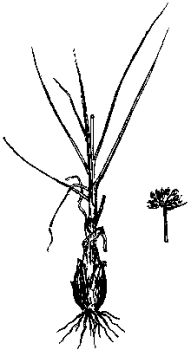 Synonyms: None
Synonyms: NoneAllium guttatum Steven, 1809
 Synonyms: None
Synonyms: None
Common names: Engl: Spotted onion; Russ: Luk krapchaty; Turk: Kiyi sogani; Ukr: Tsybulya krapchasta
Order: AMARYLLIDALES
Family: ALLIACEAE
Taxonomic descriptions: It is a bulbous perennial grass plant 30-70 cm in height. Daughter bulbs and substituting bulb capsules are yellow or grey. Leaves are semicylindrical and have a chute on the top side, not narrowed to petioles. A stem thickness is about 7 mm. Flowers are associated in the top umbel floscule (without bulbs) enclosed into cover. Perianth petals are about 2.5-3.0 mm lengthwise, white with violet or brown spot in the middle, have one vein, perianth petals are combined at a base. Stamen threads are longer than perianth petals on a quarter. Interior stamen threads are extended to a top, three-toothed. A middle tooth carrying an anther is shorter than thread-like lateral ones.
 IUCN
Status:
IUCN
Status:
World level: NE
Black Sea Regional level: EN
Subregion level: CR in Ukraine
Distribution:
Habitats type, Critical habitats, Limiting factors: Littoral strip, coastal sands and cockle-shells, steppe hillsides. Critical habitats: Arabat spit sands, steppe hillsides near Simferopol. Limiting factors: small natural population size and limited distribution.
Biology: Flowering season - during July-August. Reproduction - by seeds and vegetatively.
Population trends: The population is not numerous, with a tendency to decrease.
Threats: Habitats destruction because of building, cattle grazing; elimination by local inhabitants, creation of local market-gardening.
Conservation measures taken: Special measures are absent.
Conservation measures proposed: Regular monitoring of population state; the species should be entered in the national Red Data Lists of Black Sea countries.
References:
Compiled by: L.Vakhrusheva